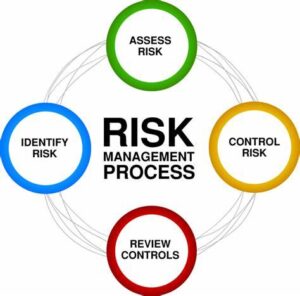The Risk breakdown structure (RBS) is a vital tool in project management it helps to identify, categorize, and assess risks in the project. In short, RBS is a hierarchical framework that breaks down potential risks into manageable components. It provides a systematic approach to understanding and managing project risks.
The Objective of Risk breakdown structure
- It organizes risks into different levels based on their categories and facilitates a comprehensive understanding of the risks involved in a project.
- The primary purpose of risk breakdown structure is to enhance risk management by enabling project managers to effectively identify, analyze, and mitigate potential threats.
Creating an Effective Risk Breakdown Structure
It requires a step-by-step process to ensure comprehensive risk identification and categorization.
- Identify Project Objectives and Scope: This will help in identifying potential risks that could impact the project’s success.
- Identify Major Project Categories: Breaking the project into major categories or work areas.
- Identify Potential Risks within Each Category: For each major category, brainstorm and identify potential risks. In both internal and external factors that impact the project.
- Determine Risk Breakdown Levels: Define the levels of breakdown within each risk category, starting from the highest level down to the specific risks.
- Assign Risk Owners and Responsibility: Assign specific individuals or teams as risk owners responsible for managing and monitoring each identified risk.
Approaches for Categorizing Risks in RBS
- Hierarchical Approach: Organizing risks in a hierarchical structure, starting from the broadest categories and drilling down to specific risks. It offers a clear overview of the risks associated with the project.
- Numerical Approach: Risks are assigned numerical values based on their severity, likelihood, or impact. This quantification allows for objective prioritization and resource allocation.
- Impact and Probability Assessment: Assessing risks based on their potential impact and probability of occurrence. Project managers can assign levels, such as low, medium, and high, to each risk based on these factors.
Practices For designing the structure:
- Clear and Consistent Risk Definitions: Use clear and consistent definitions for each risk category and sub-category. This eliminates ambiguity and facilitates accurate risk identification.
- Avoiding Overlapping and Ambiguous Categories: Ensure that each risk category and sub-category is distinct and does not overlap with others. This prevents confusion and ensures comprehensive risk coverage.
- Regularly Review and Update RBS: As the project progresses, new risks may emerge, or existing risks may evolve. Regularly reviewing and updating the risk breakdown structure ensures that it remains relevant and up to date throughout the project lifecycle.
Benefits of using RBS in structure
Risk Monitoring and Control
- Risk Tracking and Reporting: Efficient tracking and reporting of risks throughout the project lifecycle. Project managers can easily monitor the status of each risk and take necessary actions promptly.
- Targeted Risk Response Planning: RBS allows project managers to allocate appropriate resources and develop targeted risk response plans. This enables a proactive approach to risk mitigation, minimizing the impact of potential threats.
- Mitigating Project Schedule and Budget Overruns: By identifying and addressing risks early on, risk breakdown structure helps in mitigating project schedule and budget overruns. Proactive risk management ensures that potential issues are addressed promptly, minimizing disruption to project timelines and financial constraints.
Facilitating Communication and Decision-making
- Effective Risk Communication Across Stakeholders: RBS provides a common language and framework for discussing and communicating risks among project stakeholders. This enhances transparency and facilitates effective risk communication.
- Prioritizing Risk Response Actions: RBS enables stakeholders to prioritize risk response actions based on their severity and potential impact on project outcomes. This ensures that resources are allocated to address high-priority risks first.
- Supporting Informed Decision-making: RBS provides a comprehensive overview of project risks, allowing stakeholders to make informed decisions based on the potential impact of various risks. This minimizes the likelihood of making decisions without considering potential risks.
Implementing Risk Breakdown Structure in Project Management
Project managers should consider the integration with project management processes, overcome challenges and common pitfalls. For successful implementation of risk breakdown structure in project management.
Integration with Project Management Processes
Linkage to Risk Management Plan
RBS should be aligned with the overall risk management plan of the project. The RBS structure should complement other risk management processes, such as risk identification, assessment, response planning, and monitoring.
Integration with Work Breakdown Structure (WBS)
RBS and work breakdown structure (WBS) are interconnected and should be integrated to ensure comprehensive project management. risk breakdown structure provides the risk perspective, while WBS focuses on the project’s deliverables and tasks.
Incorporation into Project Scheduling and Monitoring
RBS should be incorporated into project scheduling and monitoring mechanisms. This allows project managers to allocate appropriate time and resources for risk management activities and track the progress of risk response plans.
Overcoming Challenges and Common Pitfalls
- Lack of Stakeholder Collaboration: Successful implementation of risk breakdown structure requires active involvement and collaboration from all project stakeholders. Lack of collaboration can hinder the effectiveness of risk breakdown structure and limit its benefits.
- Insufficient Risk Analysis and Assessment: Inadequate analysis and assessment of risks can lead to incomplete or inaccurate RBS. Project managers should dedicate sufficient time and resources to thoroughly analyze and assess potential risks.
- Inadequate Tools and Resources: Lack of appropriate tools and resources can impact the effectiveness of RBS. Project managers should ensure that they have access to suitable risk management software and expertise to support RBS implementation.
Conclusion
In Short, the risk breakdown structure (RBS) is a powerful tool in project management that assists in identifying, categorizing, and mitigating potential risks. project managers can enhance risk identification, streamline risk monitoring and control, and facilitate communication and decision-making. Integrating risk breakdown structure with project management processes, overcoming challenges, contribute to effective project risk management. That leads to successful project outcomes.
Recommended Reads:
Project selection methods for project managers
Top 50 Project Management Interview Questions And Answers
Top 12 PMP Certification Courses In Hyderabad
Best PMP Courses Online with Certification & Placement Assistance: 2024
FAQs
Q.1. What is the difference between Risk Breakdown Structure (RBS) and Work Breakdown Structure (WBS)?
RBS focuses on categorizing and analyzing project risks, while WBS breaks down a project into tasks and deliverables. RBS provides the risk perspective, while WBS provides the project’s structural perspective.
Q.2. How often should the Risk Breakdown Structure be updated?
Risk Breakdown Structure regularly reviewed and updated throughout the project lifecycle. As new risks emerge or existing risks evolve, the risk breakdown structure adjusted to ensure its relevancy and effectiveness.
Q.3. Can RBS use for non-project management purposes?
RBS is primarily used in project management, the principles of risk breakdown and categorization adapted and applied to various domains outside of project management.
Q.4. What is the role of the Risk Owner in RBS?
The Risk Owner is responsible for managing and monitoring specific risks identified within the RBS. They are accountable for implementing appropriate risk response plans and coordinating necessary actions to mitigate the identified risks.
Q.5. How does RBS contribute to proactive risk management?
RBS enhances proactive risk management by providing a structured framework for the identification, assessment, and monitoring of project risks. By identifying potential risks early on and implementing targeted risk response plans, project managers can reduce the likelihood and impact of risks, ensuring the project’s success.

















